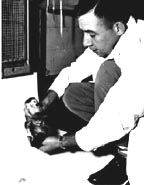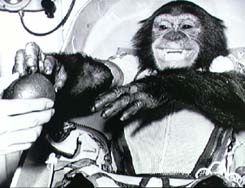LAIKA

The Soviet Union launched a series of Sputnik satellites. Sputnik
2 carried a dog named Laika into space on November 2, 1957. She
was first living creature to orbit the Earth. Sources describe
her as either a mixed-breed or a Husky. She lived for seven days
in space, until her oxygen supply was exhausted. Her vital signs
were monitored by sensors and transmitted to the Earth via telemetry
signals.
The Sputnik 2 spacecraft weighed 1120 pounds.
GORDO
 |
The U.S. Army launched a squirrel monkey named Gordo aboard a Jupiter AM-13 booster. The launch date was December 13, 1958. Gordo made the suborbital flight with no adverse effects, but could not be recovered because the flotation mechanism of the rocket's nose cone failed. |
|
|
|
|
|
The U.S. launched two monkeys on a Jupiter booster on May 28, 1959. Both monkeys survived the 300 mile flight into space and were recovered. This was a suborbital flight.
One of the monkeys was a female rhesus monkey named Able. The other was a female squirrel monkey named Baker.
The two monkeys were instrumented with electrodes to monitor their vital signs during the flight. After the flight, Able died on an operating table as doctors performed surgery to remove the sensors from underneath her skin. The cause of death was the anesthetic.
